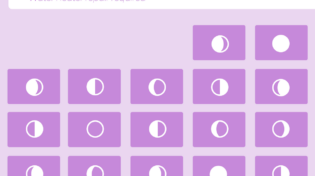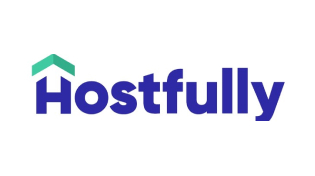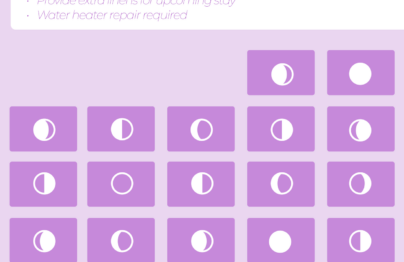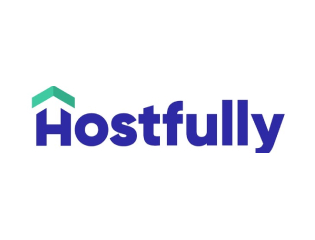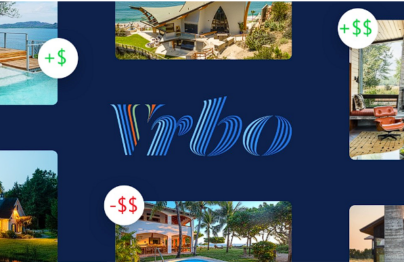Revenue Management Best Practices: Building a Revenue Management Strategy in Hospitality
December 26, 2022 | Hailey Friedman
When you’re in the hospitality industry, managing your revenue can quickly become complex. Revenue fluctuates based on demand, season, and more, making it important to understand revenue management best practices to help optimize profits.
To navigate these fluctuations, it’s helpful to use the right revenue management tools and systems for your business. Finding the right strategy helps you optimize profit while reducing vacancy rates.
Keep reading to learn how revenue management works and discover the steps to creating the best revenue management strategy this year.
What is Revenue Management?
Revenue management is the strategic practice of determining how much to charge your guests for a stay. It includes everything from what you charge for nightly stays to the costs of amenities and ancillary services.
Revenue management is the strategic pricing of rooms and ancillary services for increased profitability. It considers holidays, seasonality, market trends, events, and more to determine the right distribution and pricing of a property’s rooms, facilities, and amenities to the right demographic at the right time.
It’s all about supply and demand. Whether it’s lowering prices during the week or hiking them on holidays, prices are optimized to improve revenue without turning away your customers.
Revenue management is essential to profitability in short-term rental or hotel management businesses.
It helps property managers:
Prepare mitigation strategies for low seasons (i.e. discounts and deals)
Boost revenue through upsells and dynamic pricing
Target the right customers
Maximize occupancy and attract customers
Address costs
Who uses Revenue Management?
There are a variety of hospitality industries that rely on revenue management systems. Of course, the main industry is hotels. Big hotels and resorts use revenue management and often hire revenue managers, to figure out how much they should list their rooms for and when they should adjust their pricing. This allows for flexible, dynamic pricing that increases profits while still meeting customers’ needs.
Short-term rentals are starting to occupy the same retail space that hotels used to, so it’s no surprise that many are also starting to use hotels’ business strategies. Even individual short-term rental properties can benefit from a full suite of revenue management software. Since revenue management is so flexible, it can be used for a building with hundreds of rooms or a single cottage in a person’s backyard.
Keep in mind that revenue management isn’t just for businesses that offer people a place to stay. Just about any part of the hospitality industry can benefit from trying revenue management.
The concept originated in the airline industry. We all know booking a flight to Florida for a week from now will be much more expensive than a few months away. Many businesses know consumers will pay more for the same product under certain conditions, like time of year, availability, and more, so there’s an opportunity to implement dynamic pricing strategies.
Some other common examples of industries that use revenue management include car rental agencies, casinos, and catering services. Just about any industry with limited, time-sensitive inventory and variable demand can benefit from revenue management.
Challenges to Building Revenue Management Strategies
Revenue management strategies can be highly effective. However, it’s not always a simple task to incorporate revenue management into your business.
Here are some of the challenges that businesses face when considering a revenue management system, and strategies to overcome them.
Volatility
The market is constantly changing, yet revenue management requires you to make predictions about what the market will be like in the future. If you’re not able to accurately predict market volatility, you can run into problems.
For example, consider a case where you’re running a hotel in a town known for its annual harvest festival. If you fail to remember that demand for rooms rises due to the number of tourists attending the festival, you’ll end up having to rent your rooms for your standard cost while competitors have temporarily increased their prices (and made an extra profit).
To combat all this uncertainty, it’s important to stay up to date on market changes and trends. The typical revenue management strategy will involve collecting data from past years and closely analyzing the prices of similar businesses in your area. You will need to use all these details to make an informed decision for your revenue plan.
However, even if macro trends are stable from year to year (seasonality, holidays) micro trends can change quickly due to different areas of growth, new regulations and laws, and more.
Complications
Since revenue management is all about finding times of high demand and determining how much customers are willing to pay, you have to consider many factors and think about how they all interact with each other.
For example, each of your units could have different layouts and benefits. Think about your corner unit with floor-to-ceiling windows vs your internal units. Or, the varying safety of the neighborhoods where you have different properties, which is largely out of your control.
Something small like a big storm rolling through during a holiday weekend may cause customers to change their plans, and your pricing might not correspond with the new circumstances.
Countless complications can affect pricing, from weather to local events to social media trends, and you have to stay on top of all these details if you want to make the most of your revenue management.
Time Constraints
With so many different factors influencing revenue management, you might be tempted to spend hours pouring over data and experimenting with different pricing strategies. However, it’s important to remember that revenue management is supposed to be a cost-effective strategy.
You’ll also need to keep in mind that your strategies are often time-sensitive. You may need to act fast if you want to avoid missing certain pricing opportunities.
To make the most out of your time, using revenue management software can collect, organize, and analyze massive amounts of data for you at an efficient rate. For example, the Wheelhouse Pricing Engine analyzes 10 billion data points every night to provide real-time insights to power your business.
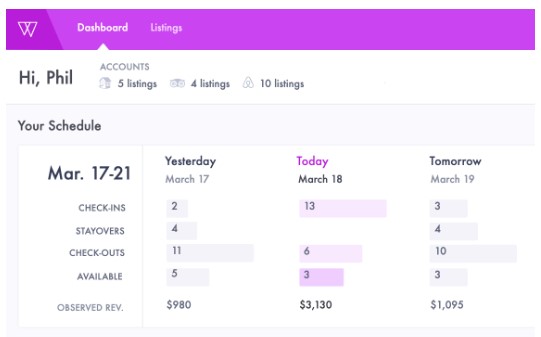
Changes Over Time
The hospitality industry is always growing and evolving. Things move fast in the digital age, so common business practices can change overnight. For example, it’s becoming common for hotels to add a cleaning fee to each room cost. However, there has been growing backlash against this trend, and some businesses are finding that they lose customers when they add a cleaning fee at the last moment.
It’s important to have a revenue management strategy that shifts as the hospitality industry changes. While in the past you might have made decisions based on your intuition or the expertise of a specialist on your team, these strategies are hard to duplicate, quantify, and convey.
Plus, they’re dependent on specific individuals within your organization, so making any changes or implementing these ideas to other parts of the team can be a struggle.
This is why documentation and articulation is so important: you can create organized, repeatable strategies for successful revenue management throughout your organization.
Best Practices for Revenue Management in the Hospitality Industry
There are a few key features you will need if you want to ensure that you have the absolute best plan possible. Always follow these industry best practices as you create your revenue management system.
1. Documentation
The first step in establishing a revenue management strategy is to document it. Articulate the strategy and step-by-step actions in a document to share with key stakeholders.
Documentation does more than just keep your team on the same page. It also allows the team to build and maintain trust with the business owners and executive team. When employees know what’s expected of them and their team members, they’re better able to meet those expectations, minimizing surprise issues.
If there are deviations from the strategy, the team is better able to explain any changes, the reasoning behind them, and share key communications within the organization and with customers.
Another critical area where documentation is necessary is in scaling the business. Organizations must be able to transfer knowledge quickly and easily so that new team members can be onboarded efficiently and quickly.
2. Articulation
The articulation process is all about clearly stating what the strategy is. A structure or document makes it clear to stakeholders (owners, executives, team members) exactly what’s happening in the business and why.
Articulation is the time to be overly precise and detailed. By clearly documenting the strategy, you’re turning intuition into process, allowing for future scaling or delegation to occur.
It’s common for your revenue management strategy to evolve as your business grows. Tracking any experimentations with notes and conclusions is beneficial for analysis, to share with new team members, and to keep as historical data.
3. Creating Processes
Everyone at the business should be able to check the plan and make sure they are properly following the guidelines, or “rowing in the same direction.”
Outline all the steps and processes in sequence so each team member knows what action to take and when. This is integral to keeping the process going, as well as for training new team members.
4. Tracking Metrics
When your pricing strategy goes live, it is essential to track metrics. Instead of just looking at total profit, you need to consider everything from the number of guests to times between bookings. These sorts of metrics are useful because they allow you to determine whether or not your revenue management strategy is working.
Try to take a close look at your metrics and consider things that aren’t obvious. For example, a higher room price might lead to fewer bookings. However, the reduced amount of work required for room turn over (cleaning, etc) could mean that you make more profit than expected. Tracking and analyzing metrics is usually the most complex part of revenue management, so we’ll discuss it in further detail in a moment.
5. Experimentation
Data means you can start experimenting with your revenue management system. The experimentation process allows you to look at very detailed changes, such as whether guests are more likely to book when your price ends in a zero or in a nine.
The goal of experimentation is to fine-tune your strategy. It lets you bring in new industry trends and mimic your successful competitors. By constantly experimenting with your pricing, you can fully optimize your system and find the pricing that provides you with the most revenue possible.
Revenue Management Documentation Guide
As you can see, one of the trickiest parts of revenue management is simply creating a documentation system that lets you analyze data and track your profits. This is a big task, but it doesn’t have to be complex and overwhelming.
Breaking the process down into smaller steps can make it a lot more doable. Every company’s revenue management strategy will vary a little because each hospitality business is so different. However, whether your business is big or small, there are a few key areas on which you will need to focus.
1. Segmentation
Segmentation breaks all processes down into manageable chunks. This both simplifies things and makes it easier to pull relevant information. For example, if you just need to know how one property performed in June, segmented documentation lets you look up that property without having to scroll through every bit of pricing data for all your properties.
How do you segment your portfolio? Review each property and determine the qualities that can differentiate your properties.
For instance, you may segment your portfolio by:
Neighborhood or sublocation (i.e., beachfront, villa, ski-in, ski-out cabin).
Room type/bedroom count
Property type (hotel/apartment hotel/individual property)
Available amenities
Always start with very broad categories and work your way down to more detailed groups. This allows you to look at general trends or focus on specific data.
An example of property portfolio segmentation might look like:
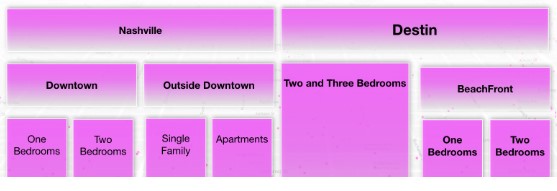
2. Demand
Another essential component to document is understanding demand. Demand allows you to see whether you need to develop a different strategy to accommodate fluctuations. There are many different metrics that you can use to track demand, so it’s important to keep a lot of data on hand.
Some differentiations include:
Seasonality (high, shoulder, low)
The day of the week
Special events
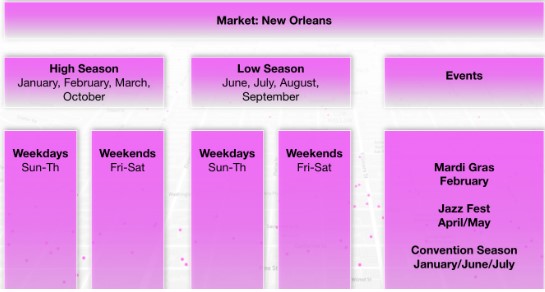
3. Booking Windows
Booking windows refer to the time periods when you must change your rates to accommodate market fluctuations. Knowing the booking window lets you raise (or lower) your rates at the right time.
The best method is to establish your price ranges on Days Before Arrival (DBA). For example, if you know your clientele book summer vacation homes two months in advance, you’ll want to change your prices before then. If you wait until one month before summer to change your pricing, you’ve missed out on additional profits.
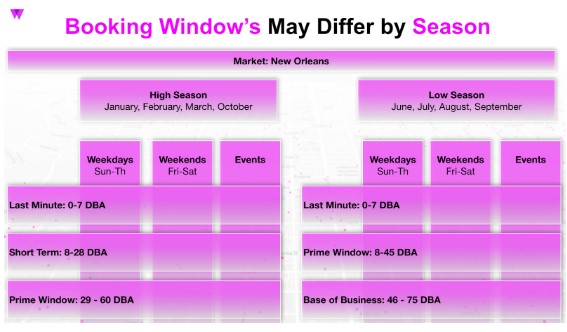
4. Build a Matrix with Tactics
A matrix is a table that lets you analyze a lot of different data at once. Matrixes are one of the most useful types of documentation for hospitality revenue management.
One of the most popular matrices includes a row for each pricing period and a separate column for pricing, nights booked, and room types. This allows you to generate a pick-up report that shows how much revenue you generate over a certain period
First, identify what you expect to occur and what you want to achieve. Then, document your tactics to ensure you don’t forget essential details during implementation.
Some questions to consider are:
How will you know when to raise rates?
How will your strategy change?
What will you try to achieve?
Arrange these in statements that provide guidelines for how you expect to operate during each booking window. Don’t forget to include triggers to tell you when to act, and what you plan to do.

5. Take Notes
Notes are invaluable for transferring knowledge to new team members and for communicating the reasons behind any changes to others in the organization.
Take the time to jot down as many notes as you can, from customer attitudes to staff reactions. These will provide context that you can use when creating future strategies.
Revenue Management Examples
So how does revenue management work in the real world? Here are some examples of ways that companies use revenue management strategies to enhance their hospitality business.
The majority of hotels increase prices during vacation months and around holidays. This is the most basic level of revenue management that almost all hospitality companies use.
Some companies find it helpful to slightly drop prices before and after an in-demand time. This encourages guests to book slightly longer stays.
Shifting to free amenities, such as laundry and WiFi, can boost revenue because it helps customers justify paying a higher price. These amenities are often cheap to provide, and guests will usually use them less than they originally intended.
Conversely, offering ancillary upsells to improve the customer experience is another good strategy. Some examples of ancillary upsells include late check-out, grocery delivery, and baby or pet sitters.
Don’t forget that you can offer different prices through different venues. This can allow you to charge corporate or wealthy clients more while still appealing to budget vacationers as well.
Offering a lower rate for longer stays can be a fantastic way of encouraging customers to book more nights.
The right revenue management strategies are one of the best ways to increase profit and optimize your business. And with the right software, it’s easy to incorporate revenue management into your hospitality organization.
Wheelhouse’s intelligent pricing software studies over 10 billion data points to recommend the perfect pricing for every rental. Because it’s dynamic, the recommended pricing changes with the market to ensure maximum occupancy.
Owners report an average increase in revenue of 40% when using Wheelhouse! Best of all, you can choose to manage your prices manually, or set-and-forget for a more hands-off approach. And as your portfolio grows, the software scales to help you manage all of your rentals.
Ready to see dynamic pricing in action?
Blog search
Recent posts
-
Wheelhouse Presents: Ratestrology
April 1, 2023 | BY Andrew Kitchell
-
Short-Term Rental Agreement: What to Include & Free Templates
January 17, 2023 | BY Hailey Friedman
-
Hostfully Review: Vacation Rental Management Software [2023]
January 14, 2023 | BY Hailey Friedman
-
Escapia Software Review [2023]
January 6, 2023 | BY Hailey Friedman



